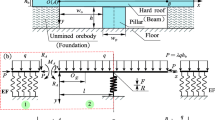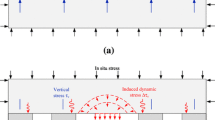Abstract
Pillars are often used to support the roof in underground mining. The multi-pillar and roof system is regarded as a multi-pillar and rock beam model. For a system composed of n pillars, the interaction force between the roof and pillars is obtained by a semi-analytical and semi-numerical method. Pillar failure may be progressive or sudden, depending on the equilibrium stability of the system in the post-peak stage. The initial conditions of multi-pillar failure and influence of one pillar progressive failure or unstable failure on adjacent pillars are analyzed based on the instability theory. If one pillar fails gradually, the stress transfer between pillars is also progressive. Once the first pillar fails suddenly, part of the stress is transferred to adjacent pillars, which may lead to further unstable failure of adjacent pillars and cascading failure of multiple pillars. The factors of pillar unstable failure mainly include geometric and mechanical parameters of the system. The mechanical parameters cannot be changed; however, entry (or stope in metal mine) geometrical parameters can be adjusted to reduce the possibility of unstable failure. The variations of pillar stability with entry widths are analyzed according to the factor of safety (FoS) and roof-to-pillar stiffness ratio rk. If the pillars are arranged in a properly concentrated manner, FoS increases, rk decreases and the tendency of pillar unstable failure increases. Conversely, if the pillars are scattered close to the barrier pillars, the possibility of pillar unstable failure is reduced but the overall strength of all pillars is also reduced. Therefore, for a multi-pillar and roof system, the entry widths should be properly adjusted from an overall system perspective to ensure that both FoS and rk values are sufficiently large to minimize the possibility of pillar unstable failure.





















Similar content being viewed by others
Abbreviations
- q :
-
Uniformly distributed force acting on rock beam
- M A, R A :
-
Bending moment and shear force of rock beam at point A, respectively
- w o_i :
-
Width of the ith entry
- w p_i :
-
Width of the ith pillar
- M B, R B :
-
Bending moment and shear force of rock beam at point B, respectively
- R i :
-
Supporting force of the ith pillar against the roof
- F i :
-
Force of the roof acting on the ith pillar
- a i, b i :
-
The distances from the ith pillar center to the boundary of barrier pillars on both sides
- E p, A :
-
Young’s modulus and cross-sectional area of pillar, respectively
- σ, ε, u :
-
Stress, strain and deformation of pillar, respectively
- ε 0, u 0 :
-
Average strain and deformation of pillar, respectively
- u i, u 0_i :
-
Deformation and average deformation of the ith pillar, respectively
- m, k p :
-
Shape parameter and initial stiffness of pillar, respectively
- w p, h :
-
Width and height of pillar, respectively
- λ :
-
Slope of pillar constitutive curve
- u c :
-
Pillar deformation corresponding to the peak strength, uc = (1/m)1/m·u0
- u c_i :
-
Deformation of the ith pillar corresponding to peak strength
- u t, λ t :
-
Deformation and stiffness at the inflection point of pillar F–u curve, ut = (1 + 1/m)1/m·u0
- h b, l :
-
Thickness and total span of rock beam (or roof), l = a i+ bi
- E b, I b :
-
Young’s modulus and inertia moment of rock beam, respectively
- y, θ :
-
Deflection and rotation angle of rock beam, respectively
- u q_i, u Rj_i :
-
Roof deformation at the ith pillar position caused by distributed force q and force Rj, respectively
- C ij :
-
Roof deformation at the ith pillar position caused by per unit force at the jth pillar position, i.e., flexibility
- K ij :
-
Stiffness influence coefficient
- U :
-
Potential energy function of a multi-pillar and roof system
- ΔW e :
-
External work acting on the pillar during unstable pillar failure process
- ΔW p :
-
Dissipated energy of pillar during unstable pillar failure process
- ΔE :
-
Excess energy that is not completely dissipated during unstable pillar failure process
- λ m :
-
The minimum slope value (negative value) in the post-peak range of all pillar constitutive curves
- η c :
-
The minimum eigenvalue of matrix K
- k i :
-
Local stiffness of the roof at the ith pillar position
- λ i :
-
Slope of the ith pillar constitutive curve
- λ t_i :
-
Post-peak stiffness of the ith pillar at the inflection point
- r k_i :
-
Stiffness ratio of the system at the ith pillar position, defined as rk_i = ki / λi. rk_i equals to the panel factor of stability (PFS).
- FoS:
-
Factor of safety
References
Adhikary DP, Shen B, Fama MED (2002) A study of highwall mining panel stability. Int J Rock Mech Min Sci 39:643–659
Bao SH, Gong YQ (2006) Structural Mechanics. Wuhan University of Technology Press, Wuhan, China
Bedford A, Liechti KM (2020) Mechanics of Materials. Springer International Publishing, Cham
Cook NGW (1965) A note on rockbursts considered as a problem of stability. J South Afr Inst Min Metall 65:437–446
Fakhimi A, Hosseini O, Theodore R (2016) Physical and numerical study of strain burst of mine pillars. Comput Geotech 74:36–44
Ghasemi E, Ataei M, Shahriar K, Sereshki F, Jalali SE, Ramazanzadeh A (2012) Assessment of roof fall risk during retreat mining in room and pillar coal mines. Int J Rock Mech Min Sci 54:80–89
Gong FQ, Yan JY, Li XB, Luo S (2019) A peak-strength strain energy storage index for rock burst proneness of rock materials. Int J Rock Mech Min Sci 117:76–89
Hauquin T, Gunzburger Y, Deck O (2018) Predicting pillar burst by an explicit modelling of kinetic energy. Int J Rock Mech Min Sci 107:159–171
He H, Dou LM, Fan J, Du TT, Sun XL (2012) Deep-hole directional fracturing of thick hard roof for rockburst prevention. Tunn Undergr Space Tech 32:34–43
Hill R (1958) A general theory of uniqueness and stability in elastic-plastic solids. J Mech Phys Solids 6:236–249
Hill D (2005) Coal pillar design criteria for surface protection. In: Proceedings of the 2005 Coal Operators' Conference. pp 26–28
Jaiswal A, Shrivastva BK (2012) Stability analysis of the proposed hybrid method of partial extraction for underground coal mining. Int J Rock Mech Min Sci 52:103–111
Kaiser PK, Tang CA (1998) Numerical simulation of damage accumulation and seismic energy release during brittle rock failure - Part II: Rib pillar collapse. Int J Rock Mech Min Sci 35:123–134
Krajcinovic D, Silva MAG (1982) Statistical aspects of the continuous damage theory. Int J Solids Struct 18:551–562
Li X, Cao WG, Su YH (2012) A statistical damage constitutive model for softening behavior of rocks. Eng Geol 143:1–17
Li WF, Bai JB, Peng S, Wang XY, Xu Y (2015) Numerical modeling for yield pillar design: a case study. Rock Mech Rock Eng 48:305–318
Linkov AM (1996) Rockbursts and the instability of rock masses. Int J Rock Mech Min Sci & Geomech Abstr 33:727–732
LYAPUNOV AM, (1992) The general problem of the stability of motion. Int J Control 55:531–534
Ma HT, Wang JN, Wang YH (2012) Study on mechanics and domino effect of large-scale goaf cave-in. Saf Sci 50:689–694
Manouchehrian A, Cai M (2016) Simulation of unstable rock failure under unloading conditions. Can Geotech J 53:22–34
Mu WQ, Wang DY, Li LC, Yang TH, Feng QB, Wang SX, **ao FK (2021) Cement flow in interaction rock fractures and its corresponding new construction process in slope engineering. Construction and Building Materials 303:124533
Pan Y, Li AW, Qi YS (2009) Fold catastrophe model of dynamic pillar failure in asymmetric mining. Mining Sci Technol 19:49–57
Prassetyo SH, Irnawan MA, Simangunsong GM, Wattimena RK, Arif I, Rai MA (2019) New coal pillar strength formulae considering the effect of interface friction. Int J Rock Mech Min Sci 123:104102
Qian MG, Miao XX, JL X, (1996) Theoretical study of key stratum in ground control. J China Coal Soc 14:225–230 ((in Chinese))
Qin SQ, Jiao JJ, Tang CA, Li ZG (2006) Instability leading to coal bumps and nonlinear evolutionary mechanisms for a coal-pillar-and-roof system. Int J Solids Struct 43:7407–7423
Rafiei Renani H, Martin CD (2018) Modeling the progressive failure of hard rock pillars. Tunn Undergr Space Tech 74:71–81
Sainoki A, Mitri HS (2017) Numerical investigation into pillar failure induced by time-dependent skin degradation. Int J Min Sci Technol 27:591–597
Salamon MDG (1970) Stability, instability and design of pillar workings. Int J Rock Mech Min Sci & Geomech Abstr 7:613–631
Starfield A, Fairhurst C (1968) How high-speed computers advance design of practical mine pillar systems. Eng Min J 169:78–84
Tang CA (1997) Numerical simulation of progressive rock failure and associated seismicity. Int J Rock Mech Min Sci 34:249–261
Wang SY, Lam KC, Au SK, Tang CA, Zhu WC, Yang TH (2006) Analytical and numerical study on the pillar rockbursts mechanism. Rock Mech Rock Eng 39:445–467
Wang SY, Sloan SW, Huang ML, Tang CA (2011) Numerical Study of Failure Mechanism of Serial and Parallel Rock Pillars. Rock Mech Rock Eng 44:179–198
Wang SL, Hao SP, Chen Y, Bai JB, Wang XY, Xu Y (2016) Numerical investigation of coal pillar failure under simultaneous static and dynamic loading. Int J Rock Mech Min Sci 84:59–68
Wang XR, Guan K, Liu J, Liu XG (2021) Instability and pillar burst mechanism in roof-pillar system with rock beam embedded in elastic foundation. Bull Eng Geol Environ 80:2447–2459
Xu YH, Cai M (2017) Influence of loading system stiffness on post-peak stress-strain curve of stable rock failures. Rock Mech Rock Eng 50:2255–2275
Zhang MT (1987) Instability theory and mathematical model for coal/rock bursts. Chin J Rock Mech Eng 6:197–204 ((in Chinese))
Zhang ZZ, Bai JB, Chen Y, Yan S (2015) An innovative approach for gob-side entry retaining in highly gassy fully-mechanized longwall top-coal caving. Int J Rock Mech Min Sci 80:1–11
Zhou ZL, Chen L, Zhao Y, Zhao TB, Cai X, Du XM (2017) Experimental and numerical investigation on the bearing and failure mechanism of multiple pillars under overburden. Rock Mech Rock Eng 50:995–1010
Zhou J, Li XB, Mitri HS (2018a) Evaluation method of rockburst: State-of-the-art literature review. Tunn Undergr Space Tech 81:632–659
Zhou ZL, Chen L, Cai X, Shen BT, Zhou J, Du K (2018b) Experimental investigation of the progressive failure of multiple pillar-roof system. Rock Mech Rock Eng 51:1629–1636
Zipf RK (2001) Toward Pillar Design to Prevent Collapse of Room-and-Pillar Mines. In: Proceedings of 108th annual meeting and exhibit, Denver, Colorado, USA.
Acknowledgements
This study was supported by Postdoctoral Science Foundation of China (No. 2020M670782), Fundamental Research Funds for Central Universities of China (No. 170104026) and National Natural Science Foundation of China (Nos. U1710253, 51904057, 52004053). The authors are very grateful for the financial contributions and convey their appreciation to the organizations for supporting this basic research.
Funding
Postdoctoral Science Foundation of China, 2020M670782, Kai Guan, Fundamental Research Funds for Central Universities of China, 170104026, **nrong Wang, National Natural Science Foundation of China, U1710253, Tianhong Yang, 51904057, **ge Liu, 52004053, Kai Guan.
Author information
Authors and Affiliations
Corresponding author
Ethics declarations
Conflict of interest
The authors declare that there is no potential conflicts of interest.
Additional information
Publisher's Note
Springer Nature remains neutral with regard to jurisdictional claims in published maps and institutional affiliations.
Rights and permissions
About this article
Cite this article
Wang, X., Yang, T., Guan, K. et al. Stability Evaluation of Multi-pillar and Roof System Based on Instability Theory. Rock Mech Rock Eng 55, 1461–1480 (2022). https://doi.org/10.1007/s00603-021-02712-8
Received:
Accepted:
Published:
Issue Date:
DOI: https://doi.org/10.1007/s00603-021-02712-8




